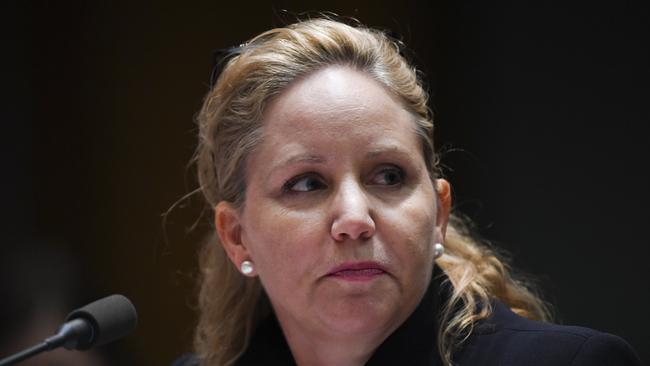Rose poses thorny problems for bank

Austrac chief executive Nicole Rose’s appearance before the Senate on Monday was a window into some of the tough board and senior management accountability issues faced by Westpac in the coming months.
As the Federal Court adjourned a scheduled mention of the Westpac case to enable mediation discussions to continue, the agency’s chief legal officer told estimates in Canberra that self-reporting by the bank had triggered Austrac’s investigation.
Westpac has previously said that senior management “promptly” reported its failure to dispatch international transfer instructions, or IFTIs, in August 2018.
This was only weeks after they first became aware of it in July.
Rose on Monday was peppered with questions by Centre Alliance senator Rex Patrick about why Austrac had “missed” Westpac’s non-compliance, and whether she’d established an internal committee to examine the issue.
“Yes, absolutely,” Rose responded, before saying it simply wasn’t possible to detect all cases of non-compliance, particularly those involving international transactions.
This was the reason why Austrac relied on the entities it regulated. When Rose said it wasn’t possible to comment further because the Westpac case was before the Federal Court, Patrick persisted, asking her if any gaps in the agency’s supervisory capacity had to be filled.
“I don’t believe there are any holes that Austrac needs to fill,” she responded.
Last November, when Austrac took court action against Westpac over millions of alleged breaches in anti-money laundering laws, Rose sensationally raised the stakes by attacking the competence of Westpac’s most senior officers.
Legal documents said the contraventions were the result of “systemic failures in Westpac’s control environment, indifference by senior management and inadequate oversight by the board”.
Chairman Lindsay Maxsted later said he was “unbelievably repulsed” that the bank’s acknowledged failure to update its detection monitoring scenarios had inadvertently facilitated child exploitation in The Philippines.
He was also chastened by Austrac’s brutal assessment of the Westpac board and senior management, which has now become a key accountability issue.
In the case of the board, it will be overseen by Ziggy Switkowski’s independent advisory panel, while management will feel the heat from Promontory Financial Group.
If the reviews confirm that senior management first heard about the Austrac issues in July and the bank self-reported to Austrac in August, the accountability case against Westpac’s senior officers might not be such an obvious slam-dunk. But that said, the bank has admitted it failed to update the child exploitation typologies for its LitePay product, as required, in December 2016.
If it had done so, Austrac would have received more suspicious matter reports.
Someone will have to carry the can for that shocking oversight.
Meanwhile, Austrac and Westpac are continuing their mediation talks.
The first hurdle to clear is an agreed statement of facts to present to the Federal Court, which would then form the basis for a penalty that’s expected to be in the $1bn range.
There is no suggestion that a breakthrough is imminent.
The hammer will drop on bank interest margins if the Reserve Bank announces another emergency rate cut on Tuesday.
With deposit rates scraping along at zero, or close enough to it, there’s little scope for banks to ease the margin-pain from lower lending rates.
You can also rest assured that Josh Frydenberg will be twisting the industry’s arm to breaking point to ensure customers benefit from maximum pass-through of the RBA rate adjustment in the shortest possible time.
That’s why UBS said on Monday it was reviewing all Australian bank ratings and price targets, pending the outcome of the RBA board meeting and any announcement from today’s meeting of the Council of Financial Regulators.
UBS noted that, despite recent share-price falls, valuations remain stretched at 1.6 times book, with banks also highly leveraged to interest rates and economic activity.
If there were any doubt about the market’s position on a rate cut, it was resolved this morning when the RBA’s overnight index swap rate, which is used to manage exposures to cash-rate movements, opened at just 0.15 per cent by August. With the RBA signalling a cash rate floor of 0.25 per cent, this suggests that investors have priced in quantitative easing.
The outlook has changed rapidly and significantly from the last RBA board meeting in February, as global equity and debt markets react to the coronavirus spreading beyond China.
It was only days ago that telco companies and banks emerged from the half-year reporting season as the only sectors with earnings upgrades.
It’s a mug’s game to try and predict the future direction of equity markets — the ASX200 has fallen 10 per cent in a week five times in the last 40 years.
Investors have just witnessed the fastest correction from a previous peak in the history of data collection.
In three of the five previous episodes (October 20, 1987; October 28, 1997; January 22, 2008; October 10, 2008 and August 8, 2011), the market subsequently rallied, up an average of 3 per cent in the following week, according to Goldman Sachs. From there, the performance was mixed.
The RBA cut the cash rate twice at its following meeting, remained on hold twice, and hiked after the January 2008 correction.
gluyasr@theaustralian.com.au Twitter: @Gluyasr


